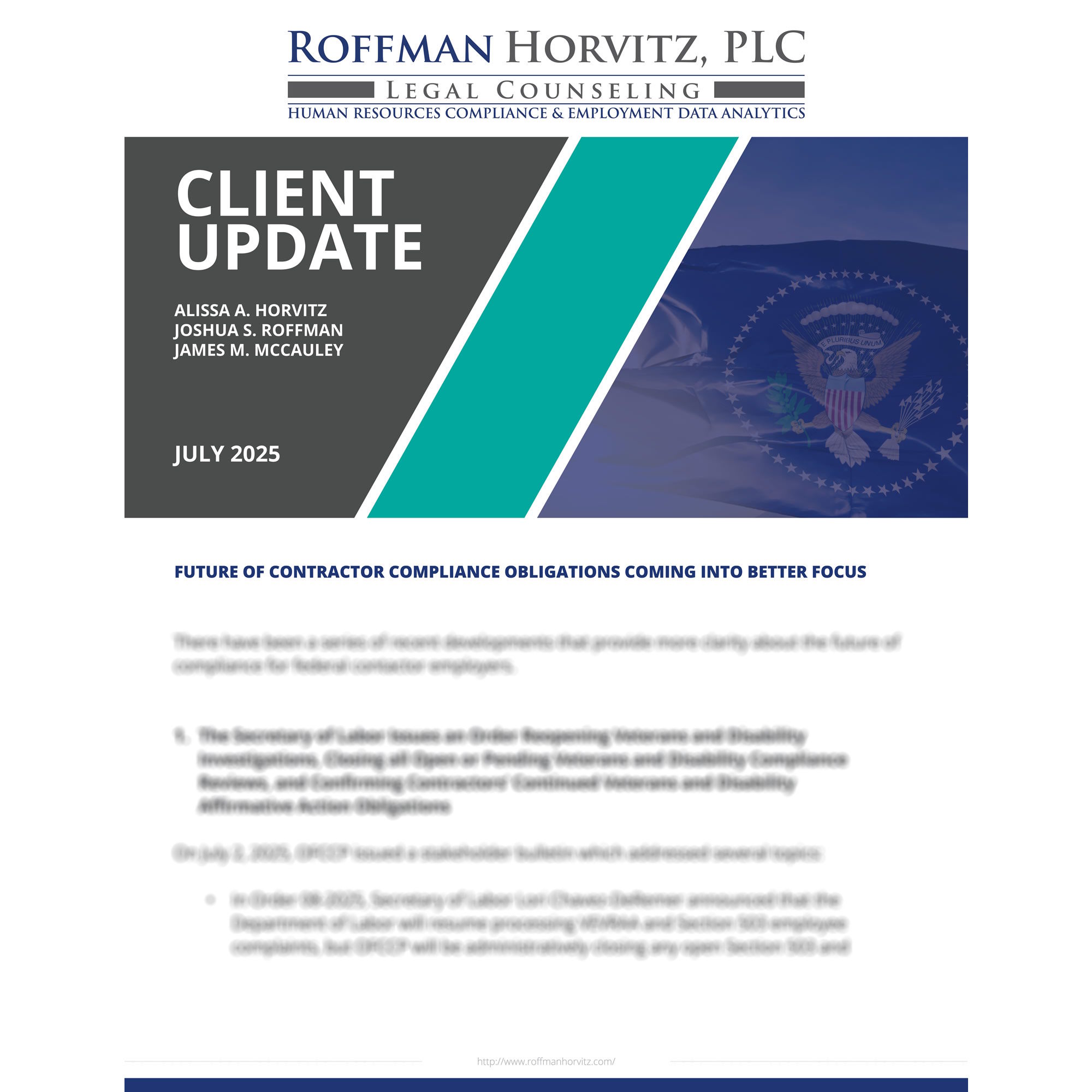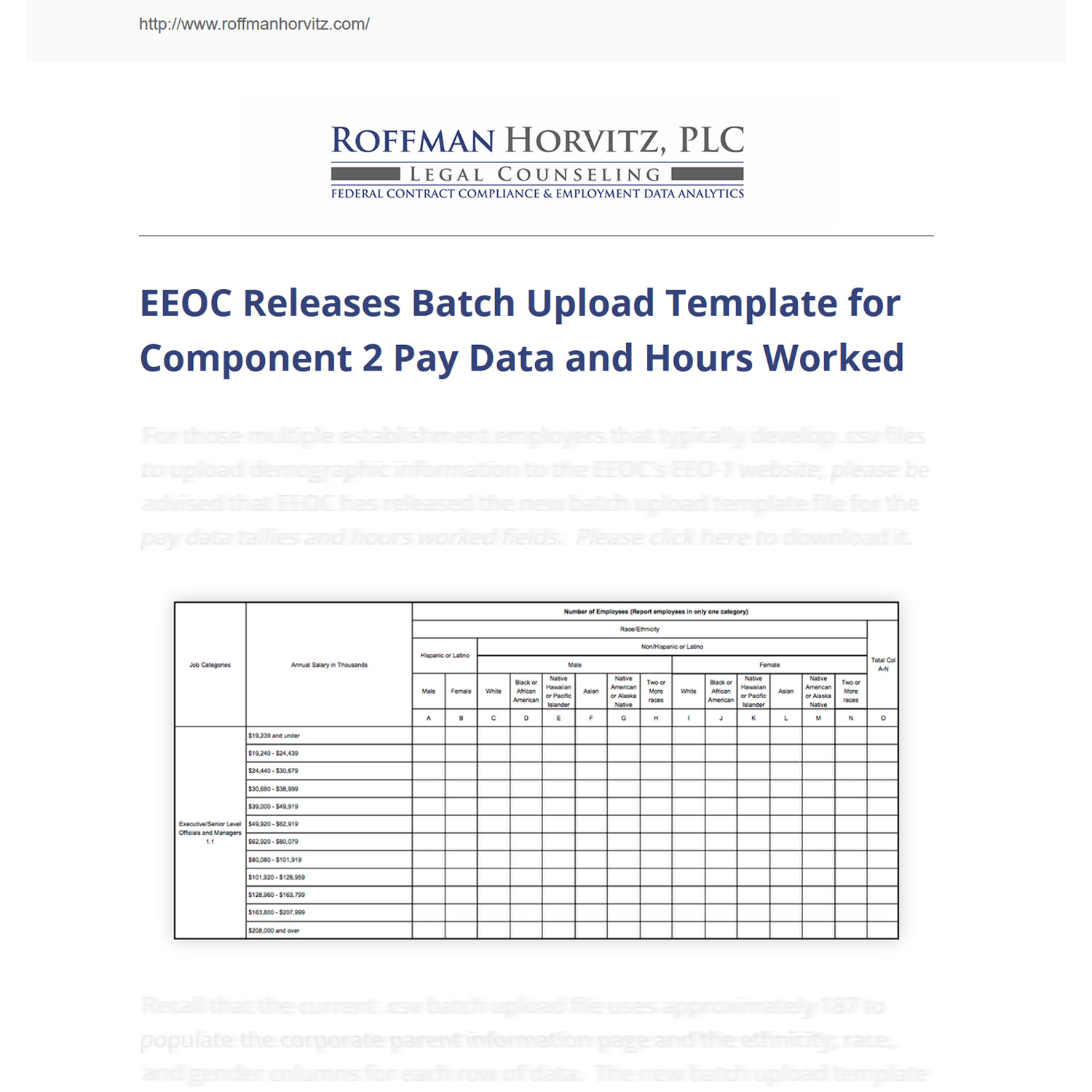Directive (DIR) 1996-01
U.S. DEPARTMENT OF LABOR
Employment Standards Administration
Office of Federal Contract Compliance Programs
Transmittal Number: 207
DATE: December 13, 1995
OFCCP ORDER NO.: ADM Notice/Other
- SUBJECT: Numerical Goals under Executive Order 11246.
- PURPOSE: To make minor clarifications in the Notice issued on August 2, 1995, on Numerical Goals under Executive Order 11246.
- BACKGROUND: On August 2, 1995, the Office of Federal Contract Compliance Programs issued a notice, signed on July 26, 1995, by Deputy Assistant Secretary Shirley J. Wilcher, to reaffirm its longstanding policy that affirmative action program goals under Executive Order 11246 are to be used as a tool to aid in breaking down barriers to equal employment opportunity for women and minorities without impinging upon the rights and expectations of other members of the workforce. Affirmative action program goals are not to be used as quotas which must be achieved through race-based and gender-based preferences.
Upon issuance of the August 2 Notice questions were raised about whether parts of Sections 4a, 4c and 5 of the Notice reflected a change in OFCCP policy. This revised Notice is being issued to reaffirm that OFCCP's longstanding policy on the appropriate uses of numerical goals in Executive Order 11246 affirmative action programs remains unchanged. Accordingly, Sections 4a, 4c and 5 have been clarified to avoid misunderstanding.
- OBSOLETE DATA: ADM Notice/Other issued on August 2, 1995, by Transmittal 206.
- FILING INSTRUCTIONS:
Holders of ADM and LEG Binders only: File at the end of the "Other" tab in your Administrative Practices Binder. Remove ADM Notice/Other, issued on August 2, 1995.
District and Area Offices EOSs and EOAs only: File behind the tab for ADM Directives in your FCCM Binder. Remove ADM Notice/Other, issued on August 2, 1995.
- DISTRIBUTION: A, B, C electronically
- EXPIRATION DATE: None
(Signed) Shirley Wilcher
SHIRLEY J. WILCHER
Deputy Assistant Secretary
for Federal Contract Compliance
August 2, 1995
Date
- SUBJECT: Numerical Goals under Executive Order 11246.
- PURPOSE: To reaffirm OFCCP's policy on the use of affirmative action program goals.
- BACKGROUND: The principles and concepts underlying the current blueprint for affirmative action programs under Executive Order 11246 were originally conceived and successfully implemented in 1961 by Plans for Progress (PfP), a group of 300 leading corporations committed to achieving equal employment opportunity through voluntary affirmative action. Each of these companies adopted a “plan for progress” for the corporation as a whole and for each of its individual establishments. These plans for progress, as a management tool for achieving equal employment opportunity, were the precursors to today's affirmative action programs.
On July 1, 1969, after having successfully tested this model over an eight–year period, PfP merged with the National Alliance of Business, and turned its focus to youth employment. Seven months later, on February 7, 1970, the Office of Federal Contract Compliance incorporated PfP's Guidelines on Affirmative Action as the centerpiece of its affirmative action program regulations applicable to the larger Federal non–construction contractors. These regulations — 41 CFR Part 60–2 — and their counterpart for construction industry contractors — 41 CFR Part 60–4 — have withstood the test of time as reasonable and successful tools that aid in breaking down barriers to equal employment opportunity for women and minorities without impinging uppon the rights and expectations of other members of the workforce.
At the time numerical goals were incorporated into the written affirmative action program regulations, the Office of Federal Contract Compliance recognized that some might misunderstand goals to be quotas which must be achieved through race–based and gender–based preferences. Accordingly, the Office of Federal Contract Compliance squarely addressed these issues in the affirmative action program regulations.
To further clarify and maintain the proper focus of affirmative action in the contract compliance program, OFCCP has periodically issued supplemental guidance and instructions explaining the difference between permissible numerical goals, on the one hand, and unlawful preferences and quotas, on the other.
The earliest and most comprehensive of these instructions was issued in 1973 as a policy statement which also was signed by the Department of Justice, the then United states civil Service commission, and the Equal Employment Opportunity Commission.
Despite these longstanding efforts by the Office of Federal Contract Compliance Programs to ensure that numerical objectives under the Executive Order are not confused wit – unlawful preferences and quotas, criticism that they involve such preferences emerges periodically. This Administrative Notice seeks to help address that criticism and reaffirm the characteristics of affirmative action program goals under the Executive Order.
- POLICY REAFFIRMATION:
- The Essence of Affirmative Action Proarams: Contractor Self–Evaluation and Self–Correction.
Affirmative action programs (AAPs), as authorized by regulations implementing Executive Order 11246, consist essentially of procedures by which Federal contractors analyze their workforce and evaluate their employment practices for the purpose of identifying and correcting any obstacles to equal employment opportunity. Where the need for corrective action is revealed, the AAP includes outreach and other steps that are precisely tailored to eliminate the barriers disclosed, and numerical goals to measure progress toward achieving that result.
- Prohibition against Quotas and Preferential Treatment.
The numerical goals component of affirmative action programs is not designed to be, nor may it properly or lawfully be interpreted as, permitting unlawful preferential treatment and quotas with respect to persons of any race, color, religion, sex or national origin. The regulations at 41 CFR 60–2.12(e), 60–2.15 and 60–2.30, specifically prohibit discrimination and the use of goals as quotas.
- Goals Are Neither Set–asides Nor a Device to Achieve Proportional Representation or Equal Results.
Numerical goals do not create set–asides for specific groups, nor are they designed to achieve proportional representation or equal results. Rather, the goalsetting process in affirmative action planning is used to target and measure the effectiveness of affirmative action efforts to eradicate or prevent barriers to equal employment opportunity. Moreover, the numerical bench marks are realistically established based on the availability of qualified applicants in the job market or qualified candidates in the employer's work force.
- There is No Requirement. Under the Affirmative Action Component, to Fill any Position on the Basis of Race or Sex.
Goals under Executive Order 11246 do not require that any specific position be filled by a person of a particular race, gender or ethnicity, even where the phenomena of jobs traditionally segregated by race or sex remain substantially in tact. Instead, the requirement is to engage in outreach and other efforts to broaden the pool of qualified candidates to include minorities and women.
- The Use of Numerical Goals is Consistent with Principles of Merit.
In seeking to achieve its goals, an employer is never retired to: 1) hire a person who does not have the qualifications needed to perform the job successfully; 2) hire an unqualified person in preference to another applicant who is qualified; or, 3) hire a less qualified person in preference to a more qualified person. Unlike preferences and quotas, numerical goals recognize that persons are to be judged on individual ability, and are, therefore, consistent with the principles of merit hiring and promotion.
- Goals May Not Be Treated as a Ceiling or a Floor.
The Executive Order does not require that contractors treat goals as either a ceiling or a floor for the employment of particular groups. Goals establish neither a minimum nor a maximum number of members of a group which must be employed. Either use of a numerical goal would be an impermissible quota.
- Compliance is Measured by Good Faith Effort.
A contractor's compliance is measured by whether it has made good faith efforts to meet its goals. Failure to meet goals is not a violation of the Executive Order. Therefore, a contractor that has not met its goals will be found in compliance if it has made good faith efforts.
- The Essence of Affirmative Action Proarams: Contractor Self–Evaluation and Self–Correction.
- IMPLEMENTATION: Whenever evidence is revealed to OFCCP – that a contractor has implemented quotas or preferences which are unlawful, it is OFCCP's policy and practice to take quick action to correct the matter, and in the same manner as if the contractor has violated the Executive Order in a different way. This practice will continue.
Compliance officers are instructed to re–emphasize the agency's policy and practice on the use of affirmative action program goals in compliance reviews, technicalassistance and other interactions with Federal contractors for the purpose of achieving compliance with the requirements of Executive Order 11246.
Each OFCCP Regional, District and Area Office will be furnished with an information kit containing information of relevance to the Federal EEO contract compliance program. The kit will be made available to members of the press and the general public who wish to be informed about affirmative action and nondiscrimination under Executive Order 11246 and other EEO laws administered by the Office of Federal Contract Compliance Programs.
- FILING INSTRUCTIONS:
Holders of ADM and LEG Binders only: File at the end of the “Other” Tab in your Administrative Practices Binder. Remove ADM Notice/Other, issued on August 2, 1995.
District and Area Offices EOSs and EOAs only: File behind the tab for ADM Directives in your FCCM Binder. Remove ADM Notice/Other, issued on August 2, 1995. - DISTRIBUTION: A, B, C, electronically
- OBSOLETE DATA: None
- EXPIRATION DATE: None
(Signed) Shirley Wilcher
SHIRLEY J. WILCHER
Deputy Assistant Secretary
for Federal Contract Compliance
August 2, 1995
Date
The contents of this document do not have the force and effect of law and are not meant to bind the public in any way. This document is intended only to provide clarity to the public regarding existing requirements under the law or agency policies.
Last updated on December 13, 1995
Download a PDF version (from the OFCCP site)

